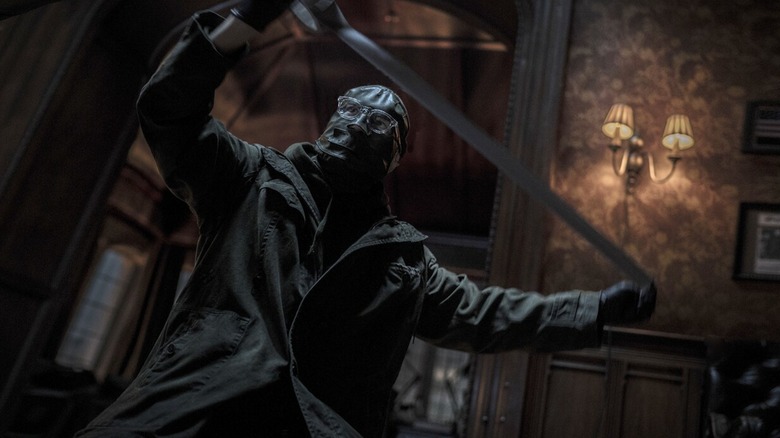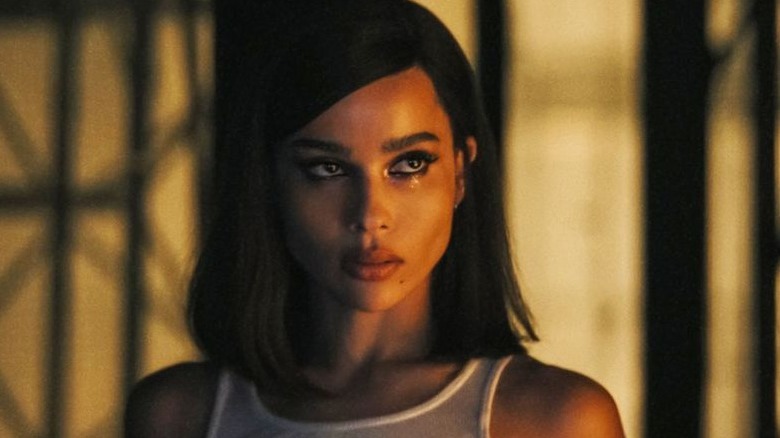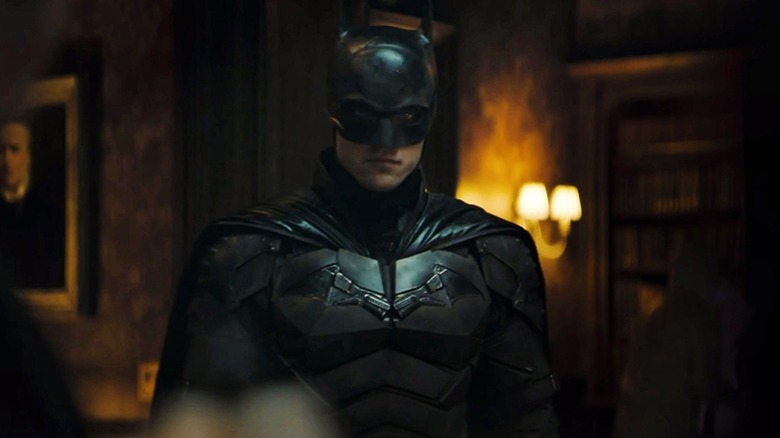The Batman Upholds The Caped Crusader's Horror Roots
Note: This article includes spoilers for "The Batman."
"The Batman" tells us it's a horror movie from its very first frame. The first shot shows a surveillance view of a happy family, their kid dressed for trick-or-treating. Within minutes, the family's seemingly friendly patriarch, who's also Gotham's mayor, will be dead. The predator's eye-view and the costumed, pumpkin-basket-holding kid at the scene's center are familiar. This feels like a sly play on John Carpenter's "Halloween," and a clue to the Riddler's (Paul Dano) own broken connection to childhood innocence. It may be the first subtle horror reference in "The Batman," but it's by no means the last.
Matt Reeves' take on the caped crusader is rife with horror, and not just in its outright homages and references. Horror seeps into the bones of this movie, dying it black and corrupting its core. The movie is rated PG-13 for elements including "strong violent and disturbing content," but with its bludgeonings, torture, and seedy underworld setting, it feels like it hovers on the edge of an R rating throughout. Moments in "The Batman" can be downright scary, but the terror isn't unprecedented: Batman comics themselves have a long legacy of horror.
Though the comic versions of Bruce Wayne and his vengeance-obsessed alter ego were originally inspired by swashbuckling characters like The Scarlet Pimpernel, it didn't take long for the hero to take a dark turn. Frank Miller's interpretation of Batman in the 1980s established a new level of brutality and was clearly drawn upon when shaping the new movie. Other beloved Batman comics dive deep into the far corners of the horror genre, with arcs like Alan Moore's "The Killing Joke" establishing that the mythology of Batman is much darker and more twisted than the limits of inspiring superhero stories typically allow. Torture and terror became de rigueur for Gotham City, with films like "The Dark Knight" and "Joker" leaning into the franchises' sadistic bent. But the city has rarely been portrayed on screen as scary, rather than dishearteningly bleak. Until now.
Reeves traffics in a type of horror that's based largely on public fear. Much later in the movie, "The Batman" nods to "Halloween" and the urban legends that inspired it again when the city's district attorney stumbles to his car after a night of partying. He finds a killer in his backseat: The Riddler lunges for him before he knows what hit him. This calls to mind another classic Michael Myers moment, sure, but it also draws upon primal fears in a way that "The Batman" does throughout its runtime. The killer in the backseat legend is used so often because it's basically a minor form of home invasion; a space that should be safe made suddenly dangerous. In this version of Gotham, the whole city lost its veneer of safety long ago, but now, the elite and powerful are beginning to feel invaded, too.
The terror of real life
If Reeves' "The Batman" has one clear influence that stands above the crowd, it's filmmaker David Fincher. "The Batman" appears to draw from "Zodiac" (both the Riddler and the real-life Zodiac have a thing for riddles and messages, and wear similarly sinister garb) as well as "Se7en." The latter, like "The Batman," is a stomach-churning hunt for a killer that culminates in a face-off between the man chasing the mysterious and a largely anonymous villain. Both times, that villain still has a few more tricks up his sleeve, even after he's been cornered. "Zodiac" and "The Batman" draw on the very human fear of being the victim of a targeted, yet seemingly senseless violent crime.
Though Finchers' precise visions of dread and violence rarely crossover into the horror classification, he's no doubt created some of the most unsettling imagery ever put to screen. Reeves aims for something similar here, albeit drawing just as much on the power of the unseen as the scene. "The Batman" lets the Riddler's kill scenes stand alone as testaments to Gotham City's terror. With his shuddery breaths, his beady eyes, and his perfect control over his kills, the Riddler seems all too real. He pulls strips of duct tape carefully, almost lovingly, to wrap around his prey. Despite his alleged moral purpose, he also seems to revel in the thrill of the chase, all but coiling up to spring on his victims. When he catches them, he's slow to act, seemingly soaking in the joy of the kill — what Heath Ledger's version of the Joker once called "savoring all the little emotions."
"The Batman" is perhaps most frightening because it draws from one of the most under-examined sources of terror and horror in the modern era: cable news. The movie builds itself on the moral panics that have locked America in a vice-grip in the past few decades. Discussions of rising crime rates are underscored by roaming gangs of violent clowns doing apparent gang initiation rituals. Vulnerable women go missing, while men unite under the banner of chaos and misinformation. Cops are broadly corrupt, and the city's infrastructure is so weak that a few coordinated actions can lead to ecological disaster. It's a mash-up of the endless stream of bleak headlines we internalize each day, and that, more than anything else, is scary.
The movie dwells in the dark
This film is heavy with horror elements, from its narrative beats down to its production design. At one point, Riddler employs a trap that looks like something straight out of a "Saw" movie. In another scene, a woman's final moments are captured on spine-chilling audio, a twist that calls to mind the '70s thriller "Klute" but has been used in dozens of horror movies since then. The entire story exists against a shady, near-chiaroscuro backdrop that feels like something out of one of the German Expressionist classics that kick-started the cinematic horror genre a century ago — and no doubt has inspired Gotham City designers since. When the screen does finally light up, it's all reds and oranges, like one of Dario Argento's perfectly lit giallos.
Batman himself moves with the plodding, heavy footsteps and immovable frame of a monster. His character theme by Michael Giacchino has all the bravado a true Gothic hero deserves, and he broods to match it. His final heroic actions even remind me of the words of Frankenstein's monster in Mary Shelley's genre-defining classic: "Life, although it may only be an accumulation of anguish, is dear to me, and I will defend it."
"The Batman" sets itself apart by examining not just the sickness, but the cure. Though it relishes taking a dip in the inky black pool of its horror trappings, the movie ultimately cleans itself up enough to make its surviving characters look admirable and helpful. Batman may be a monster forged under the weight of his own pain and trauma, but who says he has to stay that way? "The Batman" doesn't end with the fear-drenched narrative it begins with, but overall, it is the first on-screen take on Bruce Wayne that also doubles as an unabashed horror-lovers delight. It's a superhero movie that isn't afraid to show us just how dark the night can get.


